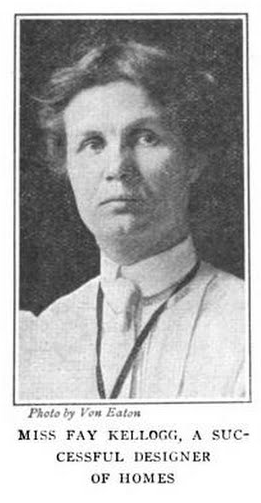Fay Kellogg facts for kids
Quick facts for kids
Fay Kellogg
|
|
|---|---|

Fay Kellogg, from a 1908 publication.
|
|
| Born | May 13, 1871 |
| Died | July 10, 1918 (aged 47) Brooklyn, New York
|
| Occupation | Architect |
Fay Kellogg (born May 13, 1871 – died July 10, 1918) was a very important American architect. Many people called her "the foremost woman architect" in the early 1900s. She was especially good at designing buildings using steel.
Contents
Becoming an Architect
Fay Kellogg was born in Milton, Pennsylvania. Her father was Albert H. Kellogg. At first, she wanted to be a doctor. She started studying at Columbian University, which is now George Washington University, in Washington, D.C..
Switching to Architecture
Her father encouraged her to try architecture instead. Fay said she was always good with tools. She had always dreamed of building her own home, which she later did! She studied with a German teacher for two years. From him, she learned drawing and math skills. Then, she studied for a year at the Pratt Institute in Brooklyn.
Early Work and Study in Paris
After her studies, Fay worked for an architect named Rudolphe L. Daus. She helped with projects like the 13th Regiment Armory. She also worked for the famous firm Carrère and Hastings for a year.
Then, Fay went to Paris to study at a special art school called an atelier. At that time, women were not allowed into the famous École des Beaux-Arts architecture school. Fay fought hard for two years to change this rule. She was successful, but it was too late for her to attend. However, her efforts helped other women, like architect Julia Morgan, get into the school later.
Starting Her Own Business
When Fay Kellogg returned to the United States in 1900, she found work with a New York architect, John Rochester Thomas. She helped design parts of the Hall of Records building. She designed the impressive double staircase inside. She also had the idea to put statues of early Dutch governors on the building.
After Thomas passed away in 1901, Fay decided to start her own architecture business. She opened her office in 1903.
Big Projects and Bold Ideas
One of her first major jobs was to fix up and build seven buildings for the American News Company in Manhattan. Soon, she was in charge of all their building work across the United States. If a project was close to New York City, Fay would go supervise it herself. For projects further away, she would draw the plans.
Fay also helped design the Woman's Memorial Hospital in Brooklyn. This hospital was started by women doctors in 1881. She designed many other buildings and homes too. She even designed suburban train stations and worked for a real estate developer on Long Island. She also built a skyscraper in San Francisco!
Fay Kellogg was not afraid to think big. She once gave an interview while standing on a steel beam nine stories high! She told the reporter, "I don't think a woman architect ought to be satisfied with small pieces, but launch out into business buildings. That is where money and name are made." She believed women should be brave and aim high, just like men.
Helping During World War I
During World War I, Fay Kellogg designed "hostess houses" for the YWCA National War Council. These were places for soldiers' families to visit them at military camps. She built them in places like Greenville, South Carolina, Charlotte, North Carolina, and Chattanooga, Tennessee. She also designed a YWCA building at the Charleston Naval Shipyard.
Fighting for Equality
Fay Kellogg played a big part in making architecture a more open profession for women. As mentioned, she fought for women to be admitted to the École des Beaux-Arts in Paris. Her efforts helped change the rules, even though she couldn't attend herself.
Working with Male Architects
Fay said her relationships with male architects were good. She believed in being treated as an equal. "I want to be treated neither as a superior nor as an inferior, but as an equal," she stated. She felt that women were very well suited to be architects. She also said that women who became architects were very serious about their work.
Supporting Women's Rights
Fay Kellogg also supported women's suffrage, which was the movement for women to get the right to vote. In 1909, she was on stage at Carnegie Hall during a speech by the famous suffragist Emmeline Pankhurst. Fay was the only architect among many professional women there.
Personal Life
Fay Kellogg owned a 15-acre (6.1 ha) farm on Long Island. She spent half the year there and sold eggs. She was working to improve the land, hoping to retire there one day.
People described Fay as a small, well-dressed woman with blue eyes. She was also very athletic! She enjoyed fencing, boxing, wrestling, and riding horses. She also played basketball and golf.
Fay Kellogg became ill in Atlanta, Georgia, in the spring of 1918. She was supervising the building of YWCA hostess houses at Camp Gordon at the time. She passed away in July 1918 at her home in Brooklyn, New York. She was 47 years old.
 In Spanish: Fay Kellogg para niños
In Spanish: Fay Kellogg para niños

